LIFE SCIENCES PAPER 2 GRADE 12 QUESTIONS - AMENDED SENIOR CERTIFICATE EXAMS PAST PAPERS AND MEMOS MAY/JUNE 2018
Share via Whatsapp Join our WhatsApp Group Join our Telegram GroupLIFE SCIENCES
PAPER 2
GRADE 12
AMENDED SENIOR CERTIFICATE EXAMS
PAST PAPERS AND MEMOS
MAY/JUNE 2018
INSTRUCTIONS AND INFORMATION
Read the following instructions carefully before answering the questions.
- Answer ALL the questions.
- Write ALL the answers in the ANSWER BOOK.
- Start the answers to EACH question at the top of a NEW page.
- Number the answers correctly according to the numbering system used in this question paper.
- Present your answers according to the instructions of each question.
- Do ALL drawings in pencil and label them in blue or black ink.
- Draw diagrams, tables or flow charts only when asked to do so.
- The diagrams in this question paper are NOT necessarily drawn to scale.
- Do NOT use graph paper.
- You must use a non-programmable calculator, protractor and a compass, where necessary.
- Write neatly and legibly.
QUESTIONS
SECTION A
QUESTION 1
1.1 Various options are provided as possible answers to the following questions. Choose the answer and write only the letter (A to D) next to the question numbers (1.1.1 to 1.1.9) in the ANSWER BOOK, e.g. 1.1.10 D.
1.1.1 Which ONE of the following is a mechanism of reproductive isolation?
- Extinction
- Breeding at different times of the year
- Mutation
- Independent assortment
1.1.2 Who formulated the law of use and disuse?
- Lee Berger
- Rosalind Franklin
- Gregor Mendel
- Jean Baptiste de Lamarck
1.1.3 Which ONE of the following features is found in BOTH humans and African apes?
- Short upper arms
- Claws instead of nails
- Opposable thumbs
- Small brain
1.1.4 Scientists made an observation that some species of butterfly are more numerous during wet summers than dry summers. In order to investigate this, the next step would be to …
- record the results.
- state a hypothesis.
- measure the results.
- draw a conclusion.
1.1.5 Which ONE of the following is the CORRECT definition of a species? A group of …
- similar organisms that live in the same habitat at the same time
- similar organisms that have the same chromosome number
- organisms that are similar in size, shape and colour
- similar organisms that are able to interbreed to produce fertile offspring
QUESTIONS 1.1.6 AND 1.1.7 REFER TO THE DIAGRAM BELOW SHOWING THE INHERITANCE OF HAEMOPHILIA IN A FAMILY. 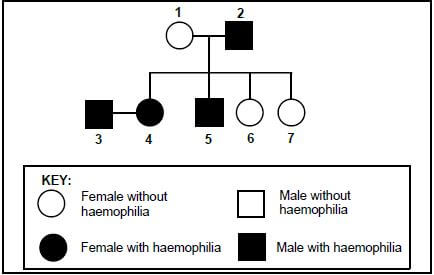
1.1.6 Which ONE of the combinations in the table below is CORRECT for BOTH individuals 1 and 5?
PHENOTYPE OF INDIVIDUAL 1 | GENOTYPE OF INDIVIDUAL 5 | |
| A | Female without haemophilia | XhXh |
| B | Female without haemophilia | XhY |
| C | Female with haemophilia | XHXh |
| D | Female without haemophilia | XHY |
1.1.7 What is the percentage chance that individuals 3 and 4 would have a child with haemophilia?
- 100%
- 75%
- 25%
- 0%
1.1.8 A dye stains a particular type of nucleic acid red. When this dye was used to identify which organelles in a cell contain this nucleic acid, only the nucleus and ribosomes stained red.
This result shows that the dye stains structures that contain …
- DNA.
- RNA.
- DNA and protein.
- both DNA and RNA.
1.1.9 Study the diagram below. 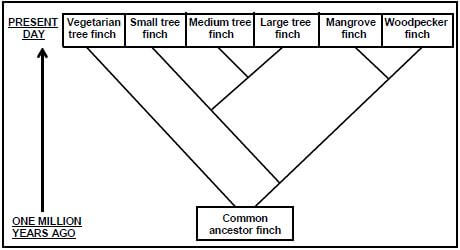
Which present-day finch is LEAST related to all the others?
- Woodpecker finch
- Large tree finch
- Mangrove finch
- Vegetarian tree finch (9 x 2) (18)
1.2 Give the correct biological term for each of the following descriptions. Write only the term next to the question numbers (1.2.1 to 1.2.8) in the ANSWER BOOK.
1.2.1 A diagrammatic representation of possible evolutionary relationships amongst species
1.2.2 The splitting of the cytoplasm during cell division
1.2.3 The process whereby DNA makes an exact copy of itself
1.2.4 A type of variation where there is a range of phenotypes for the same characteristic
1.2.5 The present-day distribution of living organisms
1.2.6 The failure of chromosome pairs to separate during meiosis
1.2.7 Similar structures in different species that show modification by descent
1.2.8 An individual having two non-identical alleles for a characteristic (8 x 1) (8)
1.3 Indicate whether each of the descriptions in COLUMN I apply to A ONLY, B ONLY, BOTH A AND B or NONE of the items in COLUMN II. Write A only, B only, both A and B or none next to the question numbers (1.3.1 to 1.3.3) in the ANSWER BOOK.
COLUMN I | COLUMN II |
1.3.1 Law of inheritance of acquired characteristics | A: Darwinism |
1.3.2 Humans select the characteristics when breeding organisms | A: Artificial selection |
1.3.3 A testable statement that may be accepted or rejected | A: Theory |
(3 x 2) (6)
1.4 The diagram below represents the process of translation. 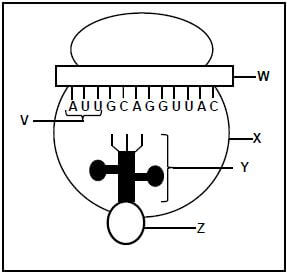
1.4.1 Name:
- Organelle X (1)
- Molecules W and Y (2)
- The monomer of molecule W (1)
1.4.2 Where in the cell is:
- Organelle X found (1)
- Molecule W formed (1) (6)
1.5 Study the graph below. 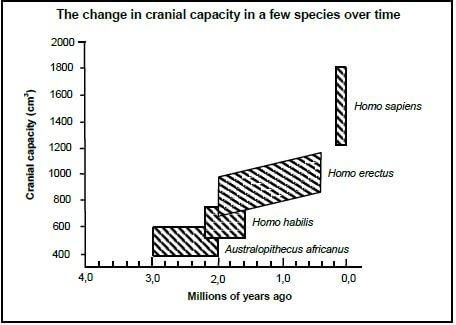
1.5.1 Name the family to which all these species belong. (1)
1.5.2 What is the largest cranial capacity (in cm3) of Australopithecus africanus? (1)
1.5.3 When did Homo habilis become extinct? (1)
1.5.4 Name TWO Australopithecus fossils found in South Africa. (2)
1.5.5 Which of the organisms represented above has the greatest range in cranial capacity? (1) (6)
1.6 Diagrams 1 to 3 below represent some of the phases of meiosis shown in the correct order. 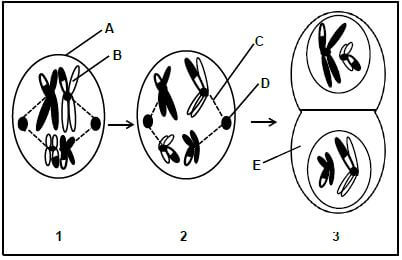
1.6.1 Identify the phase represented by diagram:
- 1 (1)
- 3 (1)
1.6.2 Give the LETTER only of the part that:
- Contains DNA (1)
- Attaches to the centromeres of chromosomes (1)
- Forms the spindle fibres (1)
1.6.3 Name the organ in a human male where meiosis occurs. (1) (6)
TOTAL SECTION A: 50
SECTION B
QUESTION 2
2.1 When a thief broke into a car he cut his arm on the broken glass. Scientists extracted DNA from the blood found on the broken glass. They analysed this DNA sample and compared it to the DNA from three suspects, P, Q and R.
The table below shows the results of the analysis for the DNA from each source. 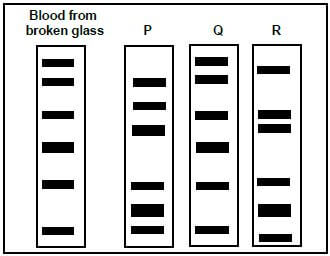
2.1.1 What do the diagrams above represent? (1)
2.1.2 Which suspect is most likely the thief? (1)
2.1.3 Give a reason for your answer to QUESTION 2.1.2. (1)
2.1.4 State TWO possible disadvantages of using this evidence in a court of law. (2) (5)
2.2 Insulin is one of the hormones responsible for the control of blood glucose levels in humans. It is made up of two long amino acid chains, A and B, which are joined. Chain A is made up of 21 amino acids and chain B of 30 amino acids.
The diagram below represents the amino acids present in each chain. 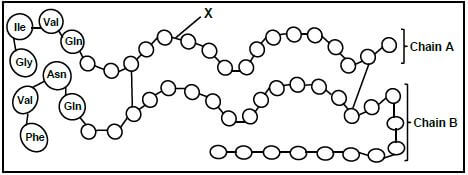
2.2.1 Name the process whereby insulin is produced in a normal human cell. (1)
2.2.2 Identify bond X. (1)
2.2.3 How many nitrogenous bases in a DNA molecule code for the amino acids in chain A? (1)
2.2.4 The table below shows the mRNA codons that code for some amino acids.
mRNA CODON | AMINO ACID |
UUC | Phenylalanine (Phe) |
AUC | Isoleucine (Ile) |
AAU | Asparagine (Asn) |
GAA | Glutamic acid (Glu) |
GUA | Valine (Val) |
CAG | Glutamine (Gln) |
CAU | Histidine (His) |
GGA | Glycine (Gly) |
- Name the nitrogenous base represented by G in the mRNA codon CAG. (1)
- Read the chains from left to right and give the:
- Codon for the fourth amino acid in chain B (1)
- DNA base triplet that codes for the first amino acid in chain A (1)
- Give the anticodon for valine. (1) (7)
2.3 Describe the process of transcription. (6)
2.4 The diagram below shows the karyotypes of two individuals. 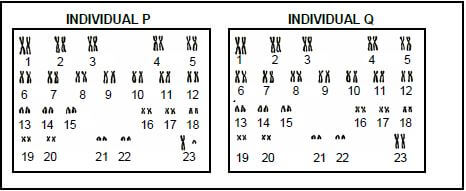
2.4.1 What term is given to the chromosomes numbered:
- 1 to 22 (1)
- 23 (1)
2.4.2 State the gender of individual P. (1)
2.4.3 Give ONE observable reason for your answer to QUESTION 2.4.2. (2)
2.4.4 Each of the pairs shown is a homologous pair of chromosomes.
State the origin of each chromosome in a homologous pair of chromosomes. (2) (7)
2.5 Lindiwe has two sons and she is now pregnant for the third time. Use a genetic cross to show the percentage chance that this child could be a boy. (6)
2.6 In dogs, coat appearance is controlled by two genes; one for coat colour and one for coat pattern (presence or absence of white patches).
The alleles for each characteristic are shown in the table below.
CHARACTERISTIC | ALLELES | |
Coat colour | Black (B) | Grey (b) |
Coat pattern | Without white patches (T) | With white patches (t) |
In a cross between two dogs, the four offspring, V, W, X and Y, had the phenotypes as shown in the diagram below. 
2.6.1 What is the term given to a genetic cross involving two characteristics? (1)
2.6.2 Give the phenotype of:
- The dominant coat colour (1)
- Dog V (1)
- A dog that is homozygous recessive for both characteristics (1)
2.6.3 Explain why all dogs with the phenotype of dog W may not have the same genotype. (2)
2.6.4 The two characteristics are inherited in accordance with Mendel's principle of independent assortment. State this principle. (3) (9)
[40]
QUESTION 3
3.1 Read the extract below.
| Stem cell surgery has been performed for the first time in South Africa at a Cape Town hospital. A patient became paralysed in a diving accident. He had no movement or feeling in any of his limbs because his nerve cells were damaged. Embryonic stem cells were used in an attempt to correct a defect in the spinal cord of the patient. He has now developed partial sensation throughout the body. |
3.1.1 Explain why stem cells are suitable cells to use for the treatment of this patient. (3)
3.1.2 Explain why some people prefer the use of umbilical cords as a source of stem cells rather than the use of human embryos. (2) (5)
3.2 A baby was kidnapped from a hospital immediately after she was born. Fifteen years later it was discovered that Mr and Mrs Thomas, who were raising her, were not her biological parents. Mr and Mrs George, whose baby was born around the same time, claimed that she was their child.
The blood groups of both families are shown in the table below.
INDIVIDUAL | BLOOD GROUPS |
Child | O |
Mr Thomas | O |
Mrs Thomas | AB |
Mr George | B |
Mrs George | A |
3.2.1 How many genes control the inheritance of blood groups? (1)
3.2.2 Name the individual whose blood group shows co-dominance. (1)
3.2.3 Explain why Mr and Mrs George could possibly be the parents of this child. (3) (5)
3.3 In a study to establish the mode of locomotion of some species, scientists compared the pelvic structure of their fossils. They established that two of these species had the ability to walk upright permanently. The diagrams (A, B and C) below show the pelvic structure of three species, drawn to scale. 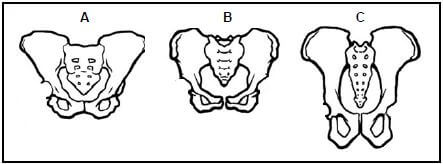
3.3.1 What term is used to describe organisms that are able to walk upright permanently? (1)
3.3.2 Which TWO diagrams above represent the pelvis of the organisms in QUESTION 3.3.1? (2)
3.3.3 Explain your answer to QUESTION 3.3.2. (2)
3.3.4 State ONE feature of the spine of the organism represented by C. (1) (6)
3.4 Tabulate THREE differences between the skulls of humans and African apes. (7)
3.5 Read the extract below.
| Brine shrimp are small arthropods found in saltwater lakes. During favourable conditions female shrimps produce eggs that hatch into live young. However, when conditions are unfavourable, the shrimp produce cysts. Each cyst contains the embryo covered with a hard, protective covering. In this state the embryo stops growing and is said to be dormant. The embryo can remain in this dormant state for many years and the cyst will only hatch at the optimum salt concentration. |
Scientists wanted to investigate which salt concentration resulted in the highest percentage of hatched cysts.
They did the following:
- Prepared salt solutions of different concentrations: 0%, 0,5%, 1%, 1,5% and 2%
- Placed 30 mℓ of each solution into one of five beakers
- Took samples of brine shrimp cysts using a dropper
- Counted the number of cysts in each sample
- Recorded this as the initial number of cysts
- Placed the samples into each of the five beakers
- Left the beakers at room temperature for 48 hours
- Recorded the number of cysts that hatched in each beaker
- Calculated the percentage of cysts that hatched
The results are shown in the table below.
SALT CONCENTRATION (%) | NUMBER OF CYSTS USED AT THE START | NUMBER OF CYSTS THAT HATCHED | PERCENTAGE OF CYSTS THAT HATCHED |
0 | 54 | 0 | 0 |
0,5 | 34 | 2 | 6 |
1 | 40 | 6 | 15 |
1,5 | 40 | 1 | 2,5 |
2 | 53 | 1 | X |
3.5.1 State TWO planning steps to consider before collecting the samples. (2) 3.5.2 State the:
- Independent variable (1)
- Dependent variable (1)
3.5.3 Calculate the value of X in the table. Show ALL working. (3)
3.5.4 State THREE factors that were kept constant in order to ensure the validity of this investigation. (3)
3.5.5 Which salt concentration resulted in the highest percentage of hatched cysts? (1)
3.5.6 Use the theory of evolution through natural selection to explain how the ability to produce cysts led to the survival of the brine shrimp. (6) (17)
[40]
TOTAL SECTION B: 80
SECTION C
QUESTION 4
There was variation in neck length in a population of Galapagos tortoises. The original population from the mainland was separated onto two islands with different environmental conditions. Many years later it was established that speciation of the tortoises had occurred.
Describe how mutations and meiosis lead to variation within a population and the role of variation in the speciation of the tortoises.
Content: (17)
Synthesis: (3)
NOTE: NO marks will be awarded for answers in the form of a table, flow charts or diagrams.
TOTAL SECTION C: 20
GRAND TOTAL: 150